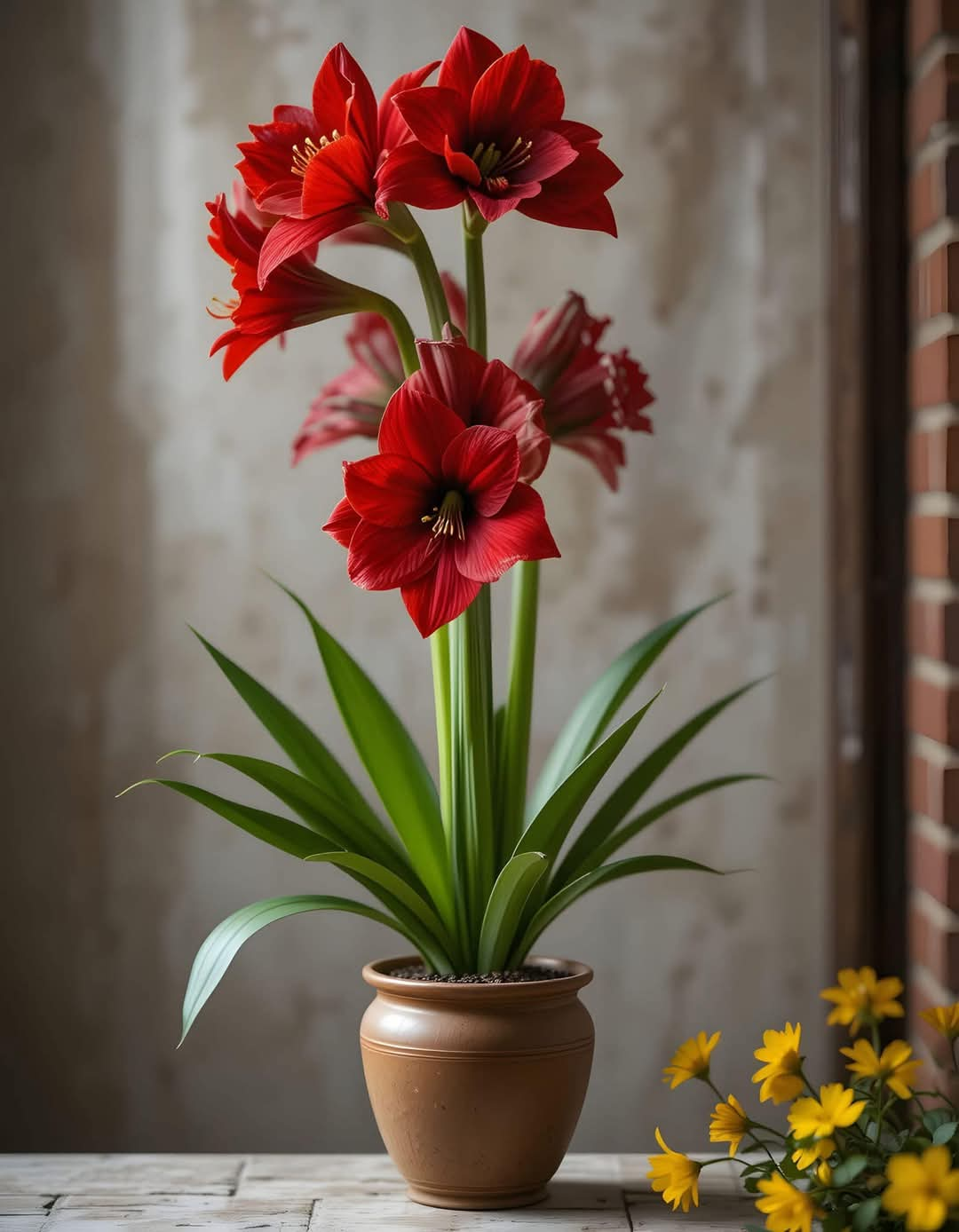Amaryllis (Hippeastrum) is a stunning flowering plant known for its large, trumpet-shaped blooms. Often associated with the holiday season, these flowers can brighten up any indoor space or garden. With proper care, Amaryllis can rebloom year after year, offering a spectacular floral display. This guide will cover everything you need to know about growing and maintaining Amaryllis successfully.
Why Grow Amaryllis?
Easy to Grow: They require minimal maintenance and thrive indoors.
Long Blooming Season: Flowers can last for weeks, and bulbs can rebloom yearly.
Perfect for Indoor & Outdoor Gardens: They make excellent potted plants and can also be grown in warm outdoor climates.
Vibrant Colors: Available in red, pink, white, orange, and striped varieties.
Ideal Growing Conditions for Amaryllis
- Light Requirements
Ideal: Bright, indirect sunlight is best for growth. A sunny south or east-facing window works well indoors.
Avoid: Deep shade, which can result in weak, leggy growth. Too much direct afternoon sun can scorch the leaves.
- Watering Needs
Ideal: Water thoroughly when the top 1-2 inches of soil feels dry. Ensure proper drainage to prevent soggy soil.
Avoid: Overwatering, as this can cause bulb rot. Allow the soil to dry slightly between waterings.
- Soil Type
Ideal: Use a well-draining potting mix rich in organic matter. A bulb-specific or container gardening mix works well.
Avoid: Heavy clay or water-retentive soils, which can cause root rot.
- Temperature and Humidity
Ideal: Amaryllis thrive in temperatures between 65-75°F (18-24°C) during the growing season.
Avoid: Frost or prolonged exposure to temperatures below 50°F (10°C). These plants are not frost-hardy.
- Fertilizing Schedule
Ideal: Feed with a balanced liquid fertilizer every 4-6 weeks after blooming, as leaves develop. This helps strengthen the bulb for the next season.
Avoid: Fertilizing during dormancy, as the plant is not actively growing.
How to Plant Amaryllis
Choosing the Right Bulb
Select a firm, healthy bulb that is large in size (bigger bulbs produce more flowers).
Planting Indoors
Choose a pot that is slightly larger than the bulb, with good drainage holes.
Fill the pot with a well-draining potting mix, leaving the top third of the bulb exposed.
Water lightly after planting to encourage root growth.
Place the pot in bright, indirect light and keep the temperature warm.
Planting in the Garden (For Warmer Climates)
Choose a sunny, well-drained spot.
Plant the bulb with half to two-thirds of it buried in the soil.
Water lightly and maintain moisture without overwatering.
Caring for Amaryllis Year-Round
During Flowering (Winter/Spring Blooming)
Keep the plant in a bright location.
Water when the soil feels dry.
Enjoy the blooms for 6-8 weeks before they fade.
After Blooming (Post-Bloom Care)
Cut back the flower stalk to about an inch above the bulb once the flowers fade.
Do not cut off the leaves—they provide energy to the bulb for future blooms.
Continue regular watering and fertilizing to nourish the bulb.
Dormancy (Rest Period for Reblooming)
If you want your Amaryllis to rebloom, allow the plant to go dormant.
Reduce watering when the leaves begin to yellow and die back.
Store the bulb in a cool, dark, dry place for 8-10 weeks.
Reblooming Process
After dormancy, repot the bulb in fresh soil if needed.
Water lightly and place in bright light to wake up the bulb.
In a few weeks, new growth will appear, leading to another beautiful bloom cycle!
Common Problems & Solutions
Amaryllis Companion Plants
If growing Amaryllis outdoors in warm climates, good companion plants include:
Lavender (keeps pests away)
Ornamental grasses (adds texture)
Ferns (provides shade to the bulb’s base)
Conclusion
Amaryllis is a spectacular and easy-to-grow flowering plant that thrives indoors and outdoors in warm climates. With proper care, watering, and dormancy periods, you can enjoy their stunning blooms year after year. Whether you’re a beginner or a seasoned gardener, growing Amaryllis will bring vibrant color and elegance to your home or garden.
More Articles You Might Like
-
Texas Toast Sloppy Joes: The Crunchy, Cheesy Upgrade You Didn’t Know You Needed
There’s something timeless about sloppy joes. For generations, this saucy, savory, and slightly sweet ground beef sandwich has been a go-to comfort food in American kitchens. It’s quick, filling, and family-friendly—perfect for busy weeknights. But what if we told you there’s a way to take this classic dish up a notch? Enter the Texas Toast…
-
Classic Pig Pickin’ Cake
When it comes to Southern desserts, few sweets shine as brightly as the Classic Pig Pickin’ Cake. This nostalgic cake, sometimes called a “Mandarin Orange Cake,” has roots deep in Southern tradition. It gets its playful name from its frequent appearance at pig pickin’s—Southern-style barbecue gatherings where communities come together to enjoy slow-cooked pork, sides,…
-
Lemon Garlic Butter Chicken with Creamy Parmesan Pasta
There’s something irresistible about the combination of tender, golden-browned chicken paired with a creamy pasta coated in Parmesan cheese. Add the brightness of lemon, the depth of garlic, and the richness of butter, and you have a recipe that feels indulgent yet approachable enough for a weeknight dinner. Lemon Garlic Butter Chicken with Creamy Parmesan…



